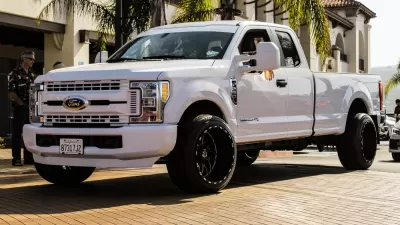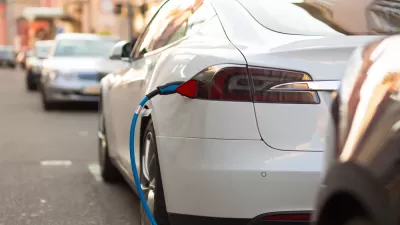Last year set two notable vehicle records. First, the most cars ever sold, at 17.54 million. Second, light trucks accounted for almost 61 percent of all sales. Sales of more fuel efficient car fell, though electric vehicle sales increased.

"The strength of new 'car' sales was actually driven by light trucks, which reached a record 60.9 percent of all sales," reports Lawrence Ulrich, The Drive’s chief auto critic. Cheap gas, by historic standards, played a significant role.
Pickups and SUVs [led by crossovers] flew out of dealerships as fast as people could pump them full of affordable unleaded. Light truck sales leapt up 7.4 percent, even as traditional cars slumped by 8.9 percent in the face of the SUV onslaught.
Fuel economy and emissions
As a result of the major increase in SUV purchases and decrease in more efficient cars, "the average fuel economy of new vehicles sold in 2016 was 25.2 mpg, down 0.1 mpg from 2015," according to an email by Michael Sivak, director of Sustainable Worldwide Transportation for the University of Michigan Transportation Research Institute, who referenced the group's latest data on vehicle fuel economy and emissions.
The drop in fuel economy translates to higher emissions. "The average new-vehicle driver produced 17% lower emissions in October 2016 than in October 2007, but 4% higher emissions than the record low reached last time in November 2015," Sivak adds.
Electric vehicle (EV) sales also set a record last year according to sales data provided by Jay Cole for Inside EVs.
In the United States, sales of all plug-in electrical vehicles (PEVs: any vehicle that has a plug and batteries so it can run on electricity, even if for only a short distance) was 159,139 last year, compared to 116,099 in 2015, an increase of 43,040 vehicles, or 37 percent. Not bad considering the price of gas!
But how does this good news compare with the total amount of vehicles sold? Less than 1 percent (0.91 percent, to be precise), not so good, but compared to last year's PEV share of 0.66 percent, it's an increase of 38 percent!
At that rate of progress, will EVs become more mainstream in the near future? One thing that will make a difference would be a significant increase in oil prices, but that appears unlikely in the near term.
FULL STORY: American Car Sales Just Set Another Record in 2016

Alabama: Trump Terminates Settlements for Black Communities Harmed By Raw Sewage
Trump deemed the landmark civil rights agreement “illegal DEI and environmental justice policy.”

Study: Maui’s Plan to Convert Vacation Rentals to Long-Term Housing Could Cause Nearly $1 Billion Economic Loss
The plan would reduce visitor accommodation by 25% resulting in 1,900 jobs lost.

Why Should We Subsidize Public Transportation?
Many public transit agencies face financial stress due to rising costs, declining fare revenue, and declining subsidies. Transit advocates must provide a strong business case for increasing public transit funding.

Wind Energy on the Rise Despite Federal Policy Reversal
The Trump administration is revoking federal support for renewable energy, but demand for new projects continues unabated.

Passengers Flock to Caltrain After Electrification
The new electric trains are running faster and more reliably, leading to strong ridership growth on the Bay Area rail system.

Texas Churches Rally Behind ‘Yes in God’s Back Yard’ Legislation
Religious leaders want the state to reduce zoning regulations to streamline leasing church-owned land to housing developers.
Urban Design for Planners 1: Software Tools
This six-course series explores essential urban design concepts using open source software and equips planners with the tools they need to participate fully in the urban design process.
Planning for Universal Design
Learn the tools for implementing Universal Design in planning regulations.
Caltrans
Smith Gee Studio
Institute for Housing and Urban Development Studies (IHS)
City of Grandview
Harvard GSD Executive Education
Toledo-Lucas County Plan Commissions
Salt Lake City
NYU Wagner Graduate School of Public Service





























